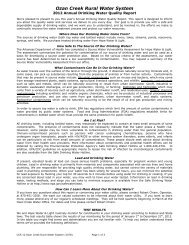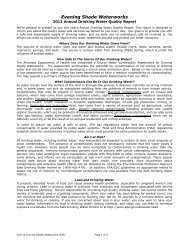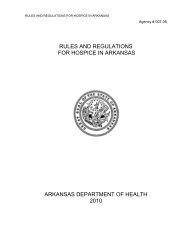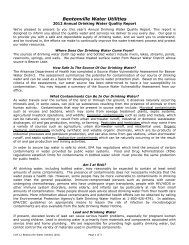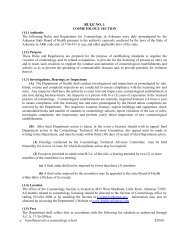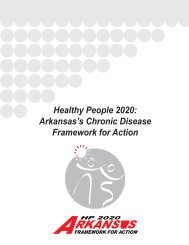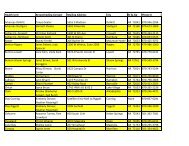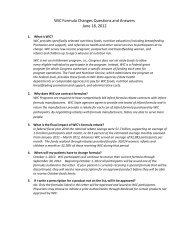Guidelines for Pool and Spa Operators - Arkansas Department of
Guidelines for Pool and Spa Operators - Arkansas Department of
Guidelines for Pool and Spa Operators - Arkansas Department of
Create successful ePaper yourself
Turn your PDF publications into a flip-book with our unique Google optimized e-Paper software.
ARKANSAS POOL CHEMICAL OPERATIONAL PARAMETERS<br />
Below are operation parameters <strong>for</strong> the proper chemical treatment <strong>and</strong> maintenance <strong>of</strong> pool/spa water. Chemical treatment alone will not produce sanitary pool water. A filtration system in proper operational condition is also<br />
required to attain sparkling clear, polished, sanitary water. *M<strong>and</strong>atory tests <strong>for</strong> compliance **Test when suspect<br />
Disinfectant<br />
Levels*<br />
Free chlorine, ppm<br />
Min Ideal Max Comments Chemical Values Min Ideal Max Comments<br />
<strong>Pool</strong> 1.0 1.0 – 3.0 5.0<br />
<strong>Spa</strong> 2.0 3.0 – 5.0 5.0<br />
Where stabilizer is<br />
used<br />
Hot weather/heavy use may require operation at<br />
or near maximum level. Regular<br />
Superchlorination is recommended.<br />
pH* 7.0 7.4 – 7.6 7.8<br />
Total Alkalinity*<br />
(buffering), ppm<br />
as CaCO 3 chlorite<br />
60<br />
80 – 100<br />
calcium, lithium,<br />
sodium<br />
hypochlorites<br />
100-120<br />
sodium dichlor,<br />
trichlor, chorine<br />
gas, bromine<br />
compounds<br />
1.5 Cyanuric acid*, ppm None 25-40 100<br />
180<br />
If pH is:<br />
Too high: Low chlorine efficiency, Scale <strong>for</strong>mation, Cloudy<br />
water, Eye discom<strong>for</strong>t<br />
Too low: Rapid dissipation <strong>of</strong> disinfectant, Plaster <strong>and</strong><br />
concrete etching, Eye discom<strong>for</strong>t, Corrosion <strong>of</strong> metals,<br />
Vinyl liner damage<br />
If total alkalinity is:<br />
Too Low: pH bounce, Corrosion tendency<br />
Too High: Cloudy water, Increased scaling potential, <strong>and</strong> pH<br />
tends to be too high<br />
If stabilizer is:<br />
Too Low: Chlorine residual rapidly destroyed by sunlight<br />
Too High: May reduce chlorine efficacy<br />
Note: Stabilizer is not needed in indoor or brominated pools.<br />
These values are <strong>of</strong>fered as ppm guidelines rather than<br />
absolute values to indicate concern <strong>for</strong> accumulation <strong>of</strong><br />
impurities in the course <strong>of</strong> operation. Excessively high TDS<br />
Disinfectant Levels*<br />
may lead to hazy water, corrosion <strong>of</strong> fixtures, etc., <strong>and</strong> can<br />
Total dissolved solids 300 1000-2000 3000<br />
Combined chlorine, Min Ideal Max Comments<br />
be reduced by partial draining with addition <strong>of</strong> fresh water.<br />
ppm**<br />
High initial TDS may indicate poor water quality due to<br />
corrosive mineral salts, humus, or organic matter. Consult<br />
local water authority.<br />
High combined results in reduced chemical<br />
Operation <strong>of</strong> pools at maximum hardness will depend on<br />
efficacy.<br />
Calcium hardness,<br />
alkalinity (buffering) requirements <strong>of</strong> the sanitizer used.<br />
<strong>Pool</strong> None None 0.2<br />
150 200-400 500-1000<br />
ppm**<br />
Minimum alkalinity <strong>and</strong> lower pH must be used with<br />
Take remedial action to establish break point<br />
maximum hardness (Over 50ppm)<br />
chlorination.<br />
If heavy metals, such as copper, iron, manganese, are<br />
<strong>Spa</strong> None None 0.2 Other signs <strong>of</strong> combined chlorine: Sharp<br />
present: Staining may occur, Water may discolor, Chlorine<br />
Heavy metals** None None<br />
chlorine odor, Eye irritation, Algae growth<br />
dissipates rapidly, Filter may plug, May indicate pH too low,<br />
corrosion, etc.<br />
Disinfectant<br />
Levels* Min Ideal Max Comments Temperature Max Comments<br />
Bromine, ppm<br />
<strong>Pool</strong> 2.25 2.25 – 4.0 4.0 <strong>Spa</strong> 104°F For 1 5 minute intervals on a timer<br />
<strong>Spa</strong> 2.25 3.0 – 5.0 5.0<br />
Disinfectant<br />
Levels*<br />
Iodine, ppm<br />
Min Ideal Max<br />
--- --- ---<br />
Comments<br />
Levels not established<br />
Note: Local Health <strong>Department</strong> <strong>of</strong>ficials must be<br />
consulted be<strong>for</strong>e use.<br />
Oxidation Reduction<br />
Potential<br />
Min Ideal Max<br />
ORP 650 --- ---<br />
Comments<br />
When chlorine or bromine is used as the primary disinfectant,<br />
ORP can be used as a supplemental measurement <strong>of</strong> proper<br />
sanitizer activity. The use <strong>of</strong> ORP testing does not eliminate or<br />
supersede the need <strong>for</strong> testing the sanitizer level with st<strong>and</strong>ard<br />
test kits. An ORP reading may be affected by a number <strong>of</strong><br />
factors including (1) pH, (2) probe film, (3) cyanuric acid, <strong>and</strong><br />
(4) other. Follow manufacturer‘s recommendations.




